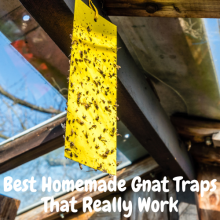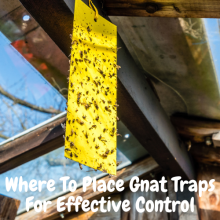Review Of Popular Gnat Trap Products | HelpHowTo
Summary of Review of Popular Gnat Trap Products
Gnats can be an infuriating pest around homes and gardens, but effective trapping provides a solution. Popular trap types include vinegar traps that use fermented lures, funnel traps with one-way entries, and sticky surfaces. Top brands like Terro, Katchy, Rescue and FreshForce offer various designs balancing odor, indoor/outdoor use, waste reduction and pricing. Reusable traps are eco-friendly but require maintenance, while disposables are convenient but wasteful.
Other factors include pet safety, placement and bait strength. The article highlights top picks across categories and emerging innovations like solar power, smartphone connectivity and new attractants beyond fruit. However, prevention through cleanliness and reducing gnat breeding sources remains crucial, using traps alongside repellents. With many effective, low-waste options available, proactive control can eliminate these pesky gnat problems.

Our Top 5 Recommended Indoor Genat Traps
Sick of pesky gnats invading your home? Discover the top 5 indoor gnat traps to banish these annoying insects for good! Our expert reviews reveal the most effective, easy-to-use traps. From powerful UV attractants to eco-friendly vinegar traps, we’ve thoroughly tested and ranked the best solutions. Check Now

Gnat Trap Supremacy: Choosing the Best for Eliminating Pesky Gnats
Gnats are one of the most frustrating insect pests to deal with around the home and garden. While relatively harmless, their persistent presence can drive anyone up the wall. Fruit flies, fungus gnats, and other small flying nuisances seem to appear out of nowhere, swarming around ripe produce, potted plants, and damp areas. When dealing with a gnat infestation, effective trapping is one of the best ways to eliminate the problem. This review will explore the most popular gnat trap products on the market to help you win the battle against these annoying pests.
Vinegar Traps
Some of the most common and inexpensive gnat traps use simple household ingredients like apple cider vinegar or overripe fruit as bait. The gnats are lured in by the sweet, fermented scent but then become trapped when they enter the container via a funnel or hole. Setting these up is easy – just pour the vinegar into a jar or purchase a ready-made trap. However, they do require frequent cleaning and rebaitingto remain effective.
While basic vinegar traps can be made very cheaply, many prefer purchased traps with a more stylish design to blend into homes. Major brands like Terro and FreshForce offer sleek vinegar trap models. A downside is the potent vinegar odor some find unpleasant.
Funnel and Sticky Traps
Another popular option is funnel traps that allow gnats to enter through a one-way funnel into a contained chamber where they become trapped. Sticky traps use a non-toxic adhesive surface to immobilize the insects. Well-known brands like Rescue and Katchy offer combinations of these methods.
Most funnel and sticky traps are designed for discreet, indoor use with a compact size and clean appearance. However, cleaning out trapped gnats frequently is important to prevent odors and mess. Replacing sticky surfaces regularly gets expensive with disposable models.
Reusable vs Disposable
On the topic of waste, choosing between reusable and disposable gnat traps is a consideration. Reusable traps are more environmentally-friendly but require thorough cleaning between uses to remove trapped gnats and old bait. This can be time-consuming.
Disposable, single-use traps are very convenient but do produce plastic waste each time they are replaced. To cut down on costs and waste, look for traps sold in bulk value packs.
Other Key Factors
Location is key when placing gnat traps. Some are better suited for indoor use in kitchens, bathrooms or near planters while others are designed for outdoor patios, gardens and moist areas gnats breed. Review if traps are intended for indoor or outdoor use.
Pet and child safety is also important, avoiding any traps that use toxic baits or lures. Most rely on food-based baits but some use pheromone lures which could be problematic.
Another factor is odor. The fermented bait in many traps produces strong, unpleasant smells even when gnats aren’t caught. This can be off-putting in living spaces. Look for low-odor or odor-free trap options.
Finally, pricing varies drastically from economical under $10 basic traps to premium $30+ models with advanced designs. Decide your budget and needs.
Brand Comparisons
In terms of top gnat trap brands, Terro is a well-known maker of apple cider vinegar traps with both basic and decorative options at affordable prices. Reviews praise the effectiveness but note frequent cleaning and vinegar smell.
Katchy offers innovative no-smell funnel trap designs, some with replaceable sticky surfaces. Their higher price is a turn-off for some but the discreet styling is appealing.
Rescue sells disposable bag trap varieties that are very user-friendly but produce plastic waste. FreshForce is another brand with disposable and reusable vinegar trap choices.
Lesser-known eco-brands like Trapro make quality reusable traps from recycled materials if sustainability is a priority. Always compare attractant baits, design, ease of use and price when researching brands.
Top Gnat Trap Picks
Best Overall: Katchy Indoor Insect Trap
This funnel trap offers true odor-free performance in a stylish, low-profile design. The no-mess disposable sticky surface is convenient.
Best for Indoors: Terro Fruit Fly Trap
The classic decorative apple cider vinegar trap effectively captures gnats in kitchens and near plants while blending into home decor.
Best for Outdoors: Rescue Outdoor Disposable Bags
These portable outdoor traps use a pheromone lure instead of smelly baits, with disposable bag liners for easy cleaning.
Best Budget: FreshForce Vinegar Trap
You get six basic yet effective vinegar traps for a very low price with this quality budget brand option.
Most Versatile: Trapro Home & Garden Trap
The reusable, collapsible silicone design can be used indoors or outdoors with various baits for ultimate versatility.
Other Innovations
While most gnat traps still use century-old vinegar or sticky methods, some interesting innovations are emerging. Solar or USB powered trap models can provide longer performance without replacing batteries. Bluetooth and WiFi connectivity allow monitoring traps remotely via smartphone apps. Merchants like Aspect offer eco-friendly traps made from bamboo, grass, and bioponic materials.
New types of attractants beyond basic fruit lures are also being explored, using pheromones, UV light, or heat luring combined with improved trapping designs like rotary fans.
Prevention Remains Key
No matter how effective the trap, preventing gnat infestations from occurring in the first place should be the goal. Steps like keeping kitchens clean, properly storing produce, removing sources of standing water, and controlling potting soil moisture levels are crucial. Using traps in tandem with insect repellents and exclusion methods is advisable.
When gnat traps do fill up, prompt disposal is important. Many brands offer compostable bait cups or liners to discard trapped gnats in an eco-friendly way.
Conclusion
From vinegar lures to funnel and sticky designs, today’s gnat trap market offers a wide range of effective solutions. Weigh factors like odor levels, indoor/outdoor use, low waste, pet safety, and pricing to find the trap that best fits your needs and home environment. Traps can be used standalone or combined with good prevention practices.
While inconvenient, a little proactive gnat control goes a long way toward a pest-free living space. With an abundance of proven, innovative trap products available, there’s no need to let these tiny insects ruin your day. Take back your kingdom!

Our Top 5 Recommended Indoor Genat Traps
Sick of pesky gnats invading your home? Discover the top 5 indoor gnat traps to banish these annoying insects for good! Our expert reviews reveal the most effective, easy-to-use traps. From powerful UV attractants to eco-friendly vinegar traps, we’ve thoroughly tested and ranked the best solutions. Check Now
FAQs and Answers
How long do gnat traps typically last before needing to be replaced or recharged?
The lifespan of gnat traps depends on the type of trap and how heavily it is used, but here are some general guidelines:
Vinegar Traps:
- These need to be recharged or refreshed every 1-2 weeks typically
- The vinegar bait solution gets depleted and loses attractiveness over time
- The traps should be emptied of caught gnats and rinsed periodically
Funnel/Sticky Traps:
- Non-replaceable funnel traps may last 4-6 weeks before getting too full
- Sticky trap surfaces/pads usually last 2-4 weeks before drying out or getting saturated
- Brands with replaceable sticky liners can last longer with replacements
Disposable Bag Traps:
- Single-use disposable trap bags are designed to capture gnats for 2-4 weeks
- Then the entire bag/container needs to be replaced
Rechargeable/Electric Traps:
- Powered by batteries or USB, these can run continuously for several months
- Attractant cartridges may need replacement every 1-3 months depending on use
So in general, disposable traps may need full replacement monthly while reusable traps with bait/lure changes can extend to 4-8 weeks. Following brand usage instructions is recommended for optimal performance.
Are there any gnat trap products specifically designed for use around food prep areas?
Yes, there are some gnat trap products designed specifically for safe use around food preparation areas in the kitchen and pantry:
Terro Fruit Fly Traps
These apple cider vinegar based traps from Terro are made from food-safe plastic and are meant to be used discreetly around kitchens, produce storage areas, and near garbage bins. The vinegar lure is contained to avoid leaks or spills.
LiBa Pantry Moth Traps
While marketed for pantry moths, these traps use a pheromone lure instead of food baits, making them ideal for use around dry goods. The contained design prevents anything from escaping.
Flies-No-More Kitchen Gnat Traps
This trap utilizes a dual-action method with a food-based attractant pad along with a discreet sticky trap surface. It’s designed for seamless integration under cabinets or shelves.
GreenSense Fruit Fly ControlTrap
An eco-friendly option, these traps use a non-toxic, food-grade bait cone rather than open vinegar containers. They’re made for use on counters near fruits and veggies.
In general, look for “kitchen safe” or food preparation area labeled traps with secure, spill-proof designs that either use contained food baits or non-food lures like pheromones. Proper placement away from direct food contact is still advised.
Which gnat trap products are the most effective for catching and monitoring fungus gnats in houseplants/gardens?
For catching and monitoring fungus gnats in houseplants and outdoor gardens, there are some gnat trap products specifically designed for this purpose:
Gnadmngr Fungus Gnat Trap
These yellow sticky traps are meant to be placed in the soil of potted houseplants to catch fungus gnats emerging from the soil. They use a pheromone lure in addition to the sticky surface.
Garsum Fungus Gnat Killer
This product combines a yellow sticky trap with biological control agents (beneficial nematodes) that get introduced into the soil to kill fungus gnat larvae.
Dynamite Indoor Plant Stickies
Simple yellow sticky card traps that can be placed on the soil surface or stuck into plant stakes to monitor and capture fungus gnat adults.
SUN-MATE Yellow Sticky Traps
A extra-large sized sticky trap that can cover a larger surface area in outdoor gardens, greenhouses, or indoor growing areas with fungus gnat issues.
Azkeb Funnel Fungus Gnat Traps
Using a funnel design, these allow flying fungus gnats to enter but prevents their escape once inside the trap container.
Products with yellow sticky surfaces mimic the natural colors fungus gnats are attracted to. Pheromone lures and biological controls provide extra effectiveness when used together. Look for traps made specifically for fungus gnats rather than fruit flies.
How do the different attractants (pheromones, light, heat, etc.) compare in effectiveness to traditional fruit/vinegar baits?
The traditional fruit/vinegar baits used in many gnat traps are still quite effective, but some of the newer attractant technologies can offer advantages in certain situations:
Pheromone Lures
Insect pheromone lures attempt to mimic the natural scents and chemical signals that attract gnats. They can be very species-specific and effective. However, they may not work as broadly as fruit baits for different types of gnats. They also may require periodic replacement.
Light Attractants
Some traps use UV light or specific light wavelengths to lure gnats inside. Light can be quite attractive, but its effectiveness depends on the trap design to then capture the insects. Light alone may just make gnats cluster nearby.
Heat Lures
Devices that generate warmth and mimic the heat signature of ripe fruits or plant matter can attract gnats seeking food sources or breeding sites. Heat combined with other lures is most effective.
In general, traditional fruit/vinegar baits remain one of the most versatile and economical lures that work across many different gnat species. However, their strong odor can be off-putting indoors.
The other attractants have the potential to lure more discreetly and target specific gnat types. Pheromones in particular excel at this specificity. But they may require purchasing multiple lure types and cost more over time.
Many effective commercial traps actually use combinations – such as a pheromone or light lure to attract, then a fruit bait reservoir to kill or trap the insects once they arrive.
Are there any gnat trap products that use natural/botanical ingredients instead of conventional pesticides?
Yes, there are some gnat trap products that utilize natural or botanical ingredients as alternatives to conventional pesticides:
Garsum Fruit Fly Traps
These vinegar-based traps use a natural lure made from fermented plant extracts instead of just plain vinegar. They are pesticide-free.
Aspects Cedarcide Gnat Guard
This uses cedarwood oil and plant essential oils as the active ingredients to attract and kill gnats in a sticky trap design.
Green Gobbler Fruit Fly Protection
Contains corn and beet extracts as the lure, avoiding synthetic chemicals. The traps are OMRI-listed for organic use.
Natrapel Gnat Trap
Leverages sodium lauryl sulfate derived from coconuts and essential botanical oils in its attractant and trapping mechanism.
Trappify Fruit Trap Planters
An innovative planter outfitted with a trapping mechanism soaked in natural botanicals like rosemary oil rather than pesticide baits.
Many of these use combinations of organic vinegars, plant extracts and essential oils to provide the luring scents that attract gnats. The trapping surfaces use botanical active ingredients rather than synthetic insecticides too. Look for seals like OMRI organic certification if avoiding pesticides is a priority.

Our Top 5 Recommended Indoor Genat Traps
Sick of pesky gnats invading your home? Discover the top 5 indoor gnat traps to banish these annoying insects for good! Our expert reviews reveal the most effective, easy-to-use traps. From powerful UV attractants to eco-friendly vinegar traps, we’ve thoroughly tested and ranked the best solutions. Check Now





